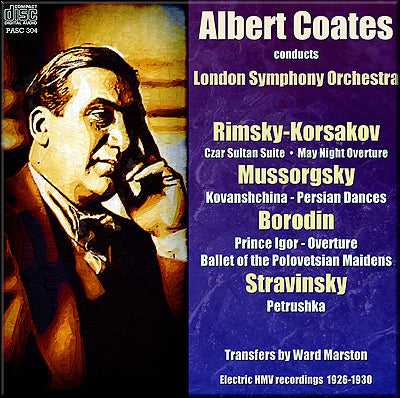
This album is included in the following sets:
This set contains the following albums:
- Full Track Listing
- Cover Art
Recorded 16 February 1928. matrices CR-1699-1A and CR-1700-1;
HMV D1491.
Matrix CR-2454-3, Recorded 8 October 1929, Queen’s Hall, transmitted by phone line to Small Queen’s Hall; matrix Cc-17848-2, recorded 5 November 1929, Hayes Main Studio.
Issued on HMV D1744.
Recorded 7 May 1930, Queen’s Hall, transmitted by phone line to Small Queen’s Hall.
Matrices CR-2486-2 and CR-2487-2; Issued on HMV D1855.
Recorded 26 October 1926, Kingsway Hall, transmitted by phone line to Small Qqueen’s Hall.
Matrices CR-815-1 and CR-816-1;Issued on HMV D1210.
Recorded 24 October 1927, Queen’s Hall, transmitted by phone line to Small Queen’s Hall; matrices CR-1554-1 and CR-1555-1A; Issued on HMV D1528.
Recorded 19 and 24 October 1927, Queen’s Hall, transmitted by phone line to Small Queen’s Hall;; 5 January and 15 February 1928. Kingsway Hall; transmitted by phone line to Small Queen’s Hall.
Issued on HMV D1521-1524.
This set was also issued on Italian and Czech HMV as well as Electrola but never on Victor.
The matrix and date information is as follows:
Side 1. CR-1542-2B (19 October 1927)
Side 2. CR-1543-3A (5 January 1928)
Side 3. CR-1544-1A (19 October 1927)
Side 4. CR-1545-4 (15 February 1928)
Side 5. CR-1546-1A (19 October 1927)
Side 6. CR-1547-2 (15 February 1928)
Side 7. CR-1552-1A (24 October 1927)
Side 8. CR-1553-2 (24 October 1927)
The present transfer was made from mid-1930s Electrola pressings, EJ381-384.
London Symphony Orchestra
Albert Coates, conductor
Electric HMV recordings 1926-30
Transfers by Ward Marston
Cover artwork based on a photograph of Albert Coates
Total duration: 73:15
Gramophone Historic Review
Hmm! Stravinsky! Now we're in for something weird!
Petrushka (1930):
"...Of
Stravinsky on her programme, " Hmm ! Stravinsky ! Now we're in for
something weird ! " What we actually were in for was the Berceuse and
Finale of The Fire Bird, which, had the printer of the programme
erroneously attributed to the pen of Rimsky-Korsakov, the good lady
would assuredly have applauded as vehemently as she did Scheherazacle at
the same concert. So much for the average Briton's attitude towards
musical progress. Yet why should early Stravinsky still be imagined by
so many to be so revolutionary and incomprehensible 7 The Fire Bird was
written in 1910— surely nineteen years is sufficient time even for an
average British concert-goer to assimilate its idiom. The answer must
lie in the fact that ever since Petrouchka Stravinsky has been such an
experimentalist, and his idiom has been so elusive, that his reputation
is better known than his music, and so our conservative concert-goers
get afraid, and refuse to become conversant with any form of music later
than Wagner. To these I would say : "Ladies and Gentlemen, go to your
gramophone dealer and listen to a few records of contemporary music ; it
will cost you nothing, and you will gain the knowledge that there is
nothing at all offensive in such works as The Fire Bird, nothing in fact
that is incompatible with the traditions of Rimsky-Korsakov, Borodin
and others ; then you will go to the concert hall and hear with
unprejudiced ears the same works, and will enjoy them."
...
In
1911 appeared Petrouchka, which is still regarded by many as
Stravinsky's masterpiece, though none can maintain that he ceased
developing at this date. Certainly his later works are more abstruse and
objective, but Stravinsky never stands still, he always moves forward,
forward, forward, and even though his followers may sometimes be led
into somewhat cacophonic by-roads, the discursions are always
interesting, and open up new paths of development. Nevertheless
Petrouchka is certainly the apex of his genius in multi-coloured
orchestral resourcefulness, and it is probably the most musically
influential of all his works ; hardly one of the younger generation of
Russian Ballet composers has escaped the influence of Petrouchka in some
form or another, and probably that is why it is the best known of his
works. Stravinsky, as I have said before, changes his style so often
that it is almost impossible to say which is the most representative of
his works, yet to a grarnophile who knows nothing of this amazing
composer's works I would recommend Petrouchka as his first introduction
to Stravinsky. Two excellent sets of Petrouchka records are available ;
one on six sides of Columbia (L2173-5), conducted by the composer, and
the other on eight sides of H.M.V. (D1521-4) by the London Symphony
Orchestra under Albert Coates. Both renderings are extremely - good the
Columbia version is the noisier, yet I think on the whole the clearer
and more supple, but I greatly regret the excision of the trumpet, flute
and bassoon trio where the Moor makes love to the ballerina. I
personally chose the H.M.V. version for its completeness."
"These Moderns 1.—Russia: Stravinsky and Prokofiev" (excerpts) by A. M. Gordon-Brown, The Gramophone, March 1930

